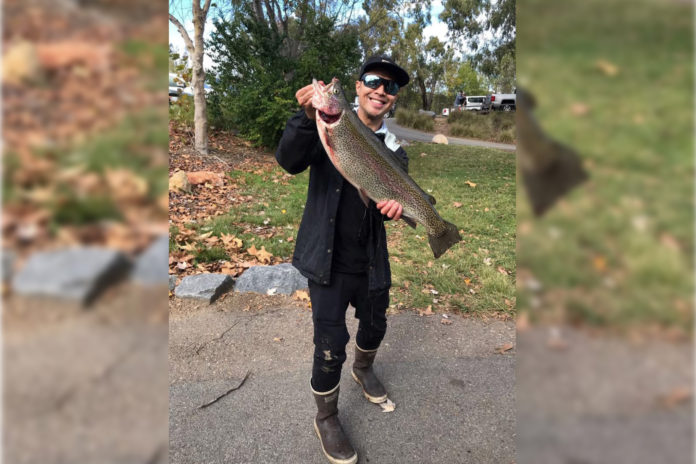Jason Casison with a whopper 6.5-pound trout caught at Dixon Lake near Pier 1 on December 23rd
Dock Totals 12/19 – 12/25: 557 anglers aboard 35 half-day to three-day trips out of San Diego landings this past week caught 124 bluefin tuna (up to 30 pounds), 2 bonito, 78 calico bass, 18 lobster (25 released), 1,788 rockfish, 22 sand bass, 30 sanddab, 239 sculpin, 21 sheephead, and 598 whitefish.
Saltwater: The local boats did not run during Christmas Eve or Christmas Day, still, given the wet weather and low number of anglers, the rockfish count was solid. The half-day runs are concentrating on high spots just off Point Loma, and while some full-day boats fished around the Coronado Islands, the bulk of what is being caught is in the bottom section of the water column. This is true down the coast past Eréndira and Punta Colonet, about 65 miles south of Ensenada. There are a few yellowtail around by the time you get to the San Quintin area, but those few spots of metered fish have proven to be slow to bite. As is with our local waters, anglers in the area are focused on sheephead, rockfish, whitefish, and lingcod.
Further south toward the mid-peninsula fisheries along the Pacific coast of Baja, yellowtail are hard to keep from biting. My old haunts around Bahia Asunción have been kicking with quality 30-pound to 50-pound yellowtail biting yoyo irons in 100 to 200 feet of water. These fish will flat wear you down and take you to the rocks if not geared up properly for them. If fishing yellowtail in that stretch of water, I’d suggest using no lighter than 60-pound test line, and given their brutish fight, two-speed reels are preferred. Not that catching them on lighter line and single-speed reels is impossible, but the hookup-to-landing ratio will greatly improve, and you will lose fewer lures.
The lures working best for yellows along the mid-peninsula coast are Deadhead Lures 4- and 6-ounce dark mint, and Salas 6x jigs in blue and white, though anything that will get deep enough quick enough has the possibility of enticing a yellow to bite. The presentation is simple; drop the lure to the bottom and wind as fast as you can until within 10 to 20 feet of the surface. In some cases, stopping the retrieve when above a metered school and letting it fall back works well, but fish will often follow the lure and not strike until near the surface, even if the fish has come up 100 feet from the school. So, wind, wind, wind as fast as you can until you can see the lure.
That area around the Vizcaino Peninsula is about where the yellowfin tuna bite begins and it gets better going south, with more and larger fish as you go. Alijos Rocks has put out a few nice 100-pound plus tuna. The focus at Alijos is on wahoo, which did not choose to bite well this past week despite them being in the area in good numbers. As the moon phase wanes back toward darker nights, I expect the wahoo bite to pick up for the long-range boats making the long trek to Alijos.
Closer to home, bluefin tuna continue to gather around Cortez and Tanner banks 120 miles or so offshore west of Point Loma. Though smaller fish to 30 pounds are what’s being caught now, boats are still metering larger fish in the area. As weather allows and the holidays pass, I expect to see more fish in the 100 and possibly 200-pound class coming over the rail before the bulk of those fish move back to the western Pacific.
Freshwater: Local lakes are stocking trout and have been long enough this season for the fish to settle into a more normal bite. Lakes Jennings, Poway, and Dixon have all reported good numbers and size for stocked trout. Santee Lakes, as always, is also a great fishery for stocked trout, and there are some decent channel cats left over from this past summer season. With the added activity, largemouth bass and channel catfish have been caught in decent numbers for those targeting them. Redear sunfish also seem to be activated by the trout plants, especially at Jennings. For trout, mini jigs and Powerbait have been producing best, while fly-lined nightcrawlers 15 to 20 feet from shore has also been a productive technique. Though not the most productive for trout, fly-lined nightcrawlers will often result in a nice by-catch of sunfish, bass, or catfish.
Though trout, along with catfish and sunfish, have been mostly cruising along the shoreline to 8 to 10-feet deep, largemouth bass are holding in deeper areas and fattening up for the coming spawn in springtime. To get them biting, I like to work the deeper ledges near points with a drop-shot Roboworm. Deep-diving crankbaits, especially trout-colored, worked along the deep side of cuts can also be productive for largemouth bass. This time of year, catfish tend to bite best on cut mackerel left sit long enough to attract them to the bait.
That’s pretty much what’s going on within ‘casting distance’ of our fine city as 2021 winds to a close. Here’s to a great 2022! Happy New Year!
Fish Plants: December 30 – Lake Poway, trout (1,500), December 31 – Santee Lakes, trout (1,500)
Credit: Source link






























